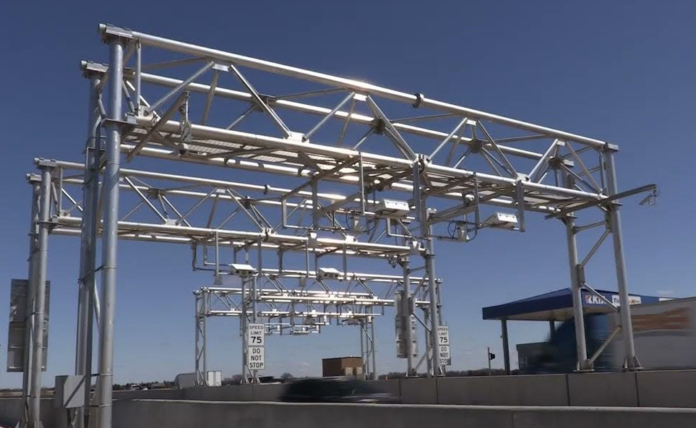The Kansas Turnpike can be tempting to any driver who doesn’t care to pay their fair share of keeping up the state’s crown jewel of highways.
Just swing left and drivers can blow by the toll plaza, the gateway to this 236-mile stretch of interstate.
Drivers can worry about settling up with the state later – if at all. During the last fiscal year, drivers raced past the toll booths roughly 1.8 million times without paying.
It seems like a high number for sure, but given the sheer volume of traffic on the turnpike, it represents just about 5% of all the trips on the highway.
In fiscal year 2022, there were about 1.6 million trips through the toll plaza without paying and about 1.1 million the year before
Overall, turnpike officials say they collect about 97% of all toll revenue, although as of Sept. 26, the agency was owed $7.5 million for unpaid tolls.
“I think we would all like to see it at 100%,” said turnpike spokesperson Rachel Bell.
“But realistically, we would have to go back to gates, and nobody likes gates,” she said.
The tolls are important because they go toward maintaining the turnpike since no state or federal funding is used on that section of interstate in Kansas.
The turnpike charges a “violation rate” for vehicles that don’t pay tolls, either because they aren’t fitted with a transponder or simply because they ignore the toll booth.
The fee is based on where vehicles leave the turnpike, which is captured on camera. It assumes the vehicles traveled the entire distance of the turnpike to that point.
If a car leaves at the southernmost entrance to the turnpike south of Wichita – and doesn’t pay a toll – the violation rate is $23.
Likewise, the fine is $23 for a car that gets off the turnpike at its easternmost entrance near Kansas City and doesn’t pay a toll.
The fines are less for cars that leave the turnpike at other points where it would be assumed that they would travel fewer miles on the turnpike.
The fine is different for other classes of vehicles, although the principle for how it’s assessed is still the same.
The agency gets tough with drivers who refuse to pay.
It will send unpaid tolls to collections and will refer cases for civil lawsuits for habitual violators or drivers the agency believes are refusing to pay.
The agency has sent $5.8 million in fines for collections, and about 1,300 drivers have been referred to an outside attorney for civil lawsuits.
The civil lawsuits are considered a last-ditch effort to collect what’s owed the turnpike, Bell said. “These are the ones we feel are really, truly trying to not pay.”
The agency also could put a hold on vehicle registrations at the Department of Revenue, but it hasn’t pursued that option so far, Bell said.
The turnpike will not move to that option until the agency moves completely to cashless tolls in 2024, which will change the entire way it deals with drivers who don’t pay tolls.
The turnpike’s decision to move completely to cashless tolls next year means the agency will deal with driver who refuse to pay differently.
There will now be equipment along the turnpike that will precisely identify where drivers enter and exit the turnpike.
At that point, the turnpike will send bills for an unpaid toll to drivers based on where they entered and exited the turnpike, just like vehicles now pay if they go through a toll booth or are equipped with a transponder.
“Instead of being a violator, you will just be a customer and we will be so much happier,” Bell said.
“We will send you a bill instead of a violation notice,” she said. “People don’t like to get violation notices.”















